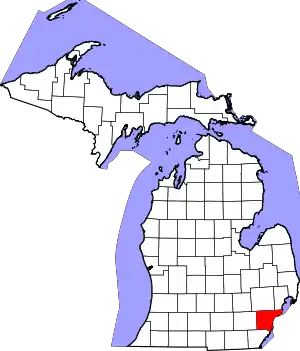| Temple Israel | |
|---|---|
| Religion | |
| Affiliation | Reform Judaism |
| Ecclesiastical or organisational status | Synagogue |
| Leadership |
|
| Status | Active |
| Location | |
| Location | 5725 Walnut Lake Road, West Bloomfield Township, Oakland County, Michigan 48323 |
| Country | United States |
 Location of the current synagogue in Michigan | |
| Geographic coordinates | 42°33′20″N 83°23′47″W / 42.55556°N 83.39639°W |
| Architecture | |
| Architect(s) | William Kapp (1950 and 1980) (Smith, Hinchman & Grylls) |
| Type | Synagogue |
| Founder | Rabbi Leon Fram |
| Date established | 1941 (as a congregation) |
| Completed |
|
| Website | |
| temple-israel | |
Temple Israel (Palmer Park) | |
 The former synagogue, now church, in 2020, located in Palmer Park Apartment Building Historic District | |
| Location | 17400 Manderson Road, Palmer Park, Detroit, Michigan 48203 |
| Coordinates | 42°25′09″N 83°06′54″W / 42.4190354°N 83.1150638°W |
| Built | 1950 |
| Architect | William Kapp |
| Architectural style | Art Moderne |
| Part of | Palmer Park Apartment Building Historic District (ID83000895) |
| Designated CP | May 21, 1983 |
| [1] | |
Temple Israel is a Reform Jewish synagogue located at 5725 Walnut Lake Road, in West Bloomfield Township, Oakland County, Michigan, in the United States.
In 2008, Temple Israel was claimed to be among the largest Reform congregations in the United States.[2] As of 2012, the congregation claimed that it is the largest congregation in North America,[3] and the official database of the Union for Reform Judaism reported that the congregation has 3,383 members.[4]
History
The congregation was founded in 1941 in Detroit,[5] in just 60 days before World War II. From the initial meeting to the first High Holiday services led by founder Rabbi Leon Fram just two months later, approximately 600 members chose to join the new congregation.
For nearly a decade, Temple Israel met in the auditorium of the Detroit Institute of Arts.
In 1949 the congregation erected an Art Moderne-style temple designed by architect William Kapp that officially opened in 1950 in the Palmer Park area of Detroit and remained the congregation's home for 30 years. Cantor Tullman was Temple Israel's first cantor until his death in 1960. Rabbi M. Robert Syme joined the Temple in 1953 to help meet the demands of the steadily growing congregation.
The Temple moved to West Bloomfield in 1980,[6] in a building located on Walnut Lake Road that was designed by Detroit architectural firm of Smith, Hinchman & Grylls, who assigned William Kapp as chief architect.[7]
The original temple in the Palmer Park area has been occupied by the Word of Power Ministry, an Evangelical Christian church, previously the Saint Paul Apostolic Temple Church, since 1989.[8] The former synagogue building was included in the National Register of Historic Places as a contributing property that is part of Detroit's Palmer Park Apartment Building Historic District, designated in 1983, with a boundary increase in 2015.[1]
The move to West Bloomfield brought significant growth and positive change. The Early Childhood Center (now named the Susan & Rabbi Harold Loss Early Childhood Center) and Tyner Religious schools were established, and the congregation grew. Temple Israel introduced new programs to help strengthen the bonds of Jewish community building. In 1995, the congregation was the first Reform congregation to open a mikveh.[9]
To modernize and address the needs of the growing congregation, Temple Israel completed additional renovations to the Sanctuary in 2017. Temple Israel has since added a host of new technological advancements to make Temple easily accessible in the virtual world - including streaming services so members can participate in our services no matter where they are.
Current leadership
Temple Israel has a unique leadership model with no 'Senior Rabbi' atop the hierarchy as most traditional multi-clergy synagogues operate. Each member of the clergy team is considered an equal. Rabbi Harold Loss is the longest-serving active member of the clergy team, joining Temple Israel in 1971. He was joined by Rabbi Paul Yedwab in 1986 and Rabbi Josh Bennett in 1995. Rabbi Marla Hornsten became the Temple's first female Rabbi in 2000 with Cantor Neil Michaels joining the clergy in 2002. Rabbi Jennifer Kaluzny and Cantor Michael Smolash came on board in the summer of 2004 with Rabbi Jennifer Lader's arrival in 2012.
The executive director of Temple Israel is Jason Plotkin who commenced in June 2022.
References
- 1 2 "National Register Information System". National Register of Historic Places. National Park Service. April 15, 2008.
- ↑ Yedwab, Paul W. (April 10, 2008). "An interview with Paul M. Yedwab, Rabbi, Temple Israel, West Bloomfield". Mlive.com (Interview). Interviewed by Alexander J. Drukas.
- ↑ "I'm New Here". Temple Israel. Archived from the original on September 15, 2012. Retrieved February 13, 2012.
- ↑ "Congregational Profile of Temple Israel". Union for Reform Judaism. Archived from the original on April 16, 2013. Retrieved February 20, 2012.
- ↑ Olitzky, Kerry M.; Raphael, Marc Lee (1996). The American Synagogue: A Historical Dictionary and Sourcebook. Westport: Greenwood Press. pp. 177–8.
- ↑ "Our History". Temple Israel. Retrieved January 19, 2021.
- ↑ Witsil, Frank (June 15, 2021). "Downton Abbey fame leads to Meadow Brook Hall architect getting credit he deserves". Detroit Free Press.
- ↑ "About us". Work of Power Ministry. n.d. Retrieved January 2, 2024.
- ↑ Fishkoff, Sue (Fall 2008). "Reimagining the Mikveh". Reform Judaism. Archived from the original on November 22, 2012.
